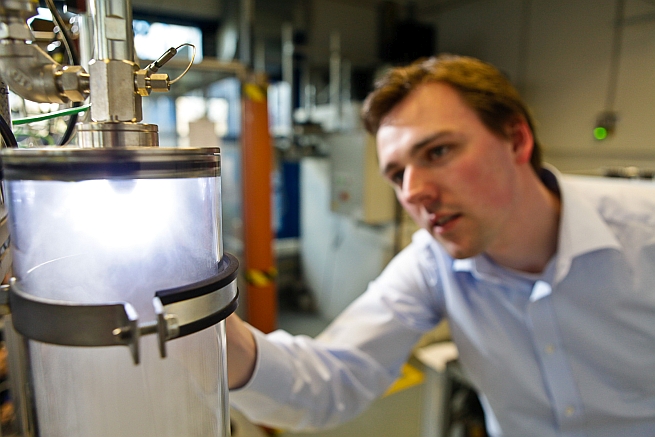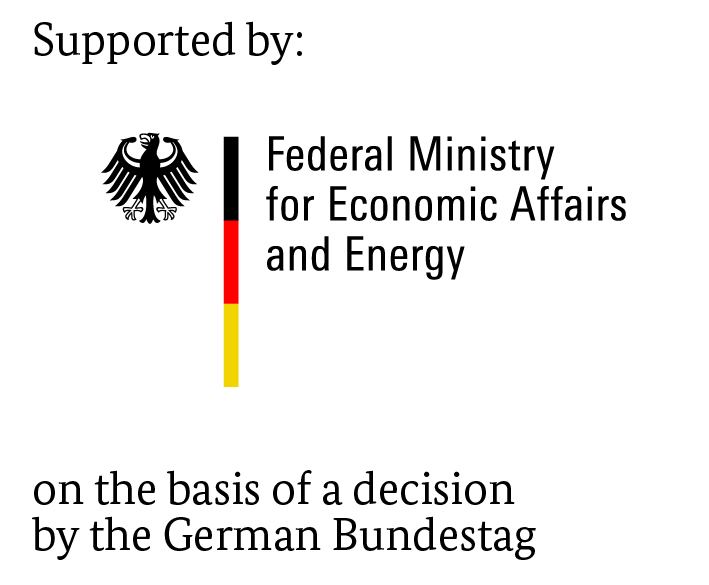Conditions for safe operation of oil heating systems investigated
08 July 2020 – With a view to climate protection, laboratory tests were carried out to investigate the addition of higher proportions of regenerative paraffinic fuels and fatty acid methyl ester to middle distillates such as heating oil and diesel fuel. Safe operation of engines and oil heating systems with different fuel mixtures is therefore possible under certain conditions.
Against the background of climate protection, biofuel oil with 10% fatty acid methyl ester (FAME) as a regenerative component has been introduced as an optional product on the heating oil market in recent years. In the fuel market, an admixture of up to 7 % FAME in diesel is standard.

Circuit test bench for testing the interaction of regenerative fuels with appliance components. Photo: OWI
In the meantime, other paraffinic fuels such as hydrogenated vegetable oils (HVO) and hydrogenated residual and waste materials as well as Fischer-Tropsch products (Power-to-Liquid (PtL) and Gas-to-Liquid (GtL) products) have been developed to such an extent that they can represent an option for the substitution of heating oil and diesel fuel of mineral oil origin. These two products, which from a chemical point of view belong to the middle distillate group, are subject to natural ageing processes during storage. Oxidation and degradation processes can be detected by chemical analyses and colour changes and turbidity can be optically detected. The admixture of alternative and biogenic liquid fuels can reinforce this. This could be observed with the introduction of biofuel oil. Under unfavourable conditions, deposits form and as a result, operational disturbances occur.
Causes of deposits
In a joint research project, OWI Science for Fuels gGmbH and the ITMC Institute for Technical and Macromolecular Chemistry at RWTH Aachen University have investigated the causes of deposit formation and interactions between biogenic and conventional fuels and materials. Questions were how the deposits that interfere with operation arise during storage in the fuel oil tank and during operation on the fuel-carrying components of the oil heating system, what chemical-physical properties they have and how such deposits can be avoided. In order to answer these questions, the two research units have applied various classical and modern analytical methods. In particular, magnetic resonance measurements with a novel tabletop NMR spectrometer from the ITMC played a key role in the structural elucidation of the composition of the deposits.
The paraffinic products in different admixture proportions (e.g. 100% HVO, 100% GtL or 10% HVO in heating oil or 10% GtL in heating oil) were largely unremarkable in their ageing behaviour. There were no operational disturbances. In contrast, fuels with different FAME contents (e.g. fuel oil with 20% FAME content or fuel oil with 26% HVO and 7% FAME) proved to be particularly susceptible to deposits.
During the long-term storage of different fuel mixtures over a period of up to 18 months, it turned out, as expected, that fuel samples with FAME contents at temperatures of 8 °C and below have a stronger tendency to form deposits than paraffinic fuels and pure mineral oil-bearing fuel oil. These deposits dissolved again when heated to room temperature. The formation of deposits due to the cold could be prevented by a suitable additive of the fuel mixtures. An analysis of cold-related deposits identified predominantly saturated monoglycerides as the cause. These had apparently not been fully processed in the production of the FAME component.
Parallel to long-term storage, OWI investigated the behaviour of the fuel mixtures in application-oriented single component and closed-loop test benches. In experiments with paraffinic test fuels, such as HVO and synthetic paraffinic fuel, only small amounts of deposits were found inside the various components. On the other hand, it was shown that the FAME portions in the fuel mixtures led to deposits, which in some cases resulted in test bench failures. The cause of these deposits was another group of substances, which mainly consisted of oxygenated FAME and long-chain alkanes and partly of polyaromatics. B20 samples (80 % fuel oil with a 20 % FAME content) added with antioxidants delayed the failure of the test stand, although the dosage of the additive remained below the
Conclusion of the researchers
In order to prevent the FAME-related tendency to deposit formation at temperatures below 8 °C, it is important to observe the following
- During FAME production, all monoglycerides should be completely converted.
- Mixtures of fuel oil and FAME must contain additives.
During fuel storage, temperatures of 15 to 18 °C usual for fuel oil cellars should be maintained, as higher temperatures lead to an acceleration of ageing processes. The use of non-ferrous metals, such as copper, in fuel-bearing components of oil heating systems also leads to faster fuel ageing and deposits and should therefore be avoided. To reduce these effects, mixtures of fuel oil and FAME with antioxidants should be added according to the manufacturer’s instructions.
Paraffinic fuels form fewer deposits because they contain fewer reactive components.
The findings of this investigation:
- New methods for the production and analysis of mixtures of middle distillates such as diesel and fuel oil and FAME should be developed,
- suitable additive products should be derived and
- mixtures of 80 % fuel oil and 20 % FAME should in future be tested in the field under practical operating conditions.
The IGF project 18951 N of the research association German Society for Petroleum and Coal Science and Technology e.V. – DGMK, Überseering 40, 22297 Hamburg is funded through the AiF as part of the program for promoting joint industrial research (IGF) by the German Federal Ministry of Economics and Energy based on a German Federal Parliament resolution.






